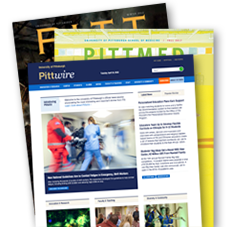"Nano-Metals" Deform Differently from Ordinary Metals, Pitt-Led Research Team Confirms
PITTSBURGH—A team of researchers led by University of Pittsburgh Professor Scott X. Mao has identified a key way in which nanocrystalline metals deform
(i.e., change shape)—thereby confirming, for the first time, that "nanostructured" metals deform differently from ordinary metals.
"These findings expand our knowledge of the nature of deformation in metals and will change the traditional way of thinking about the deformation process," said Mao, a professor in the Pitt School of Engineering's Department of Mechanical Engineering. This knowledge should help "nanoscientists"—researchers who use atoms and molecules as basic building blocks to construct minute machines, create new materials, or perform molecular tasks—to develop new metals and metal coatings with heretofore unheard-of properties (for example, super-hard coatings and metals with a high degree of plasticity).
Size matters in metal deformation, Mao explained. "Traditional, coarse-grained metals deform when parts of a grain slip past one another as extra planes of atoms, called dislocations, move through the material," he said. "But in nanoengineered metals, the grains are much smaller—say, 10- or 15-billionths of a meter in size, too tiny to see with a traditional microscope." When grain sizes are too small for dislocations, Mao said, a different kind of deformation occurs—the grain boundaries themselves move, sliding past one another. This allows the grains to rotate and find new ways of fitting together.
Theorists had for years proposed just such a transition from a dislocation-based deformation to a grain-boundary-based one. But no one had found direct evidence of the shift until Mao and his colleagues confirmed it in experiments at the National Center for Electron Microscopy (NCEM) at the U.S. Department of Energy's Lawrence Berkeley National Laboratory in Berkeley, Calif. In their work, the researchers used high-quality nickel prepared at DOE's Sandia National Laboratories in Albuquerque, N.M.
In addition to Mao, researchers involved in the project included Jorg M.K. Wiezorek, an associate professor in the Pitt engineering school's Department of Materials Science and Engineering; Zhiwei Shan, a Pitt Ph.D. student in Mao's lab; Eric A. Stach of NCEM; and David M. Follstaedt and James A. Knapp of Sandia National Laboratories. Their paper, "Grain Boundary-Mediated Plasticity in Nanocrystalline Nickel," appeared in the July 30, 2004, issue of the journal Science.
###
8/19/04/blg
Media Resources
Schools of the Health Sciences Media Relations
For more information about Pitt's schools of dental medicine, health and rehabilitation sciences, medicine, nursing, pharmacy, and public health, click here >
To locate stories from health science schools prior to 2013, visit the UPMC news archives »
Urgent Question?
University of Pittsburgh news reps are available to answer urgent media inquiries. Outside of regular business hours (Mon-Fri, 8:30 a.m.-5 p.m.), please email us at media@pitt.edu.
News reps for University of Pittsburgh Health Sciences schools can be reached outside of regular business hours through the paging operator at 1+412-647-2345.


